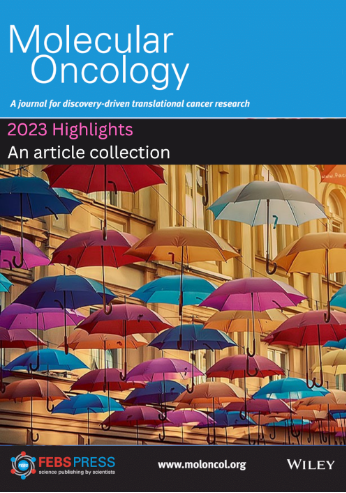靶向抑制STAT3可通过糖酵解诱导肝癌细胞免疫原性死亡
IF 5
2区 医学
Q1 ONCOLOGY
引用次数: 17
摘要
在肝细胞癌(HCC)中,信号转导子和转录激活子3(STAT3)以过度活跃的状态存在,这与肿瘤的发展和免疫逃逸密切相关。STAT3抑制重塑了肿瘤免疫微环境,但其潜在机制尚未完全阐明。我们发现,STAT3抑制可以通过“吃我”分子钙网蛋白转移到细胞表面和显著降低“不吃我”白细胞表面抗原CD47的表达,诱导HCC细胞的免疫原性细胞死亡(ICD)。STAT3抑制促进树突状细胞(DC)活化,增强巨噬细胞对HCC细胞的识别和吞噬作用。此外,STAT3抑制阻止了关键糖酵解酶的表达,促进了HCC中ICD的诱导。有趣的是,STAT3直接调节CD47和溶质载体家族2成员1(SLC2A1;也称为GLUT1)的转录。在皮下和原位移植小鼠肿瘤模型中,STAT3抑制剂napabucasin阻止肿瘤生长,诱导钙网织蛋白和蛋白二硫异构酶家族A成员3(PDIA3;也称为ERp57)的表达,但抑制CD47和GLUT1的表达。同时,肿瘤浸润的DC和巨噬细胞的数量增加,同时共刺激分子的表达也增加。肿瘤组织中积聚了更多的CD4+和CD8+T细胞,CD8+T淋巴细胞的检查点分子如淋巴细胞活化基因3蛋白(LAG-3)和程序性细胞死亡蛋白1(PD-1)的表达较低。值得注意的是,靶向STAT3的治疗诱导了抗肿瘤免疫记忆反应。这些发现为靶向STAT3诱导的HCC ICD提供了一种新的机制,并证实STAT3是通过重塑肿瘤免疫微环境治疗HCC的潜在靶点。本文章由计算机程序翻译,如有差异,请以英文原文为准。
Targeted inhibition of STAT3 induces immunogenic cell death of hepatocellular carcinoma cells via glycolysis
In hepatocellular carcinoma (HCC), the signal transducer and activator of transcription 3 (STAT3) is present in an overactive state that is closely related to tumour development and immune escape. STAT3 inhibition reshapes the tumour immune microenvironment, but the underlying mechanisms have not been fully clarified. We found that STAT3 inhibition could induce immunogenic cell death (ICD) of HCC cells via translocation of the “eat me” molecule calreticulin to the cell surface and a significant reduction in the expression of the “don’t eat me” molecule leucocyte surface antigen CD47. STAT3 inhibition promoted dendritic cell (DC) activation and enhanced the recognition and phagocytosis of HCC cells by macrophages. Furthermore, STAT3 inhibition prevented the expression of key glycolytic enzymes, facilitating the induction of ICD in HCC. Interestingly, STAT3 directly regulated the transcription of CD47 and solute carrier family 2 member 1 (SLC2A1; also known as GLUT1). In subcutaneous and orthotopic transplantation mouse tumour models, the STAT3 inhibitor napabucasin prevented tumour growth and induced the expression of calreticulin and the protein disulfide isomerase family A member 3 (PDIA3; also known as ERp57) but suppressed that of CD47 and GLUT1. Meanwhile, the amount of tumour‐infiltrated DCs and macrophages increased, along with the expression of costimulatory molecules. More CD4+ and CD8+ T cells accumulated in tumour tissues, and CD8+ T cells had lower expression of checkpoint molecules such as lymphocyte activation gene 3 protein (LAG‐3) and programmed cell death protein 1 (PD‐1). Significantly, the antitumour immune memory response was induced by treatment targeting STAT3. These findings provide a new mechanism for targeting STAT3‐induced ICD in HCC, and confirms STAT3 as a potential target for the treatment of HCC via reshaping the tumour immune microenvironment.
求助全文
通过发布文献求助,成功后即可免费获取论文全文。
去求助
来源期刊

Molecular Oncology
医学-肿瘤学
CiteScore
12.60
自引率
1.50%
发文量
203
审稿时长
6-12 weeks
期刊介绍:
Molecular Oncology highlights new discoveries, approaches, and technical developments, in basic, clinical and discovery-driven translational cancer research. It publishes research articles, reviews (by invitation only), and timely science policy articles.
The journal is now fully Open Access with all articles published over the past 10 years freely available.
 求助内容:
求助内容: 应助结果提醒方式:
应助结果提醒方式:


